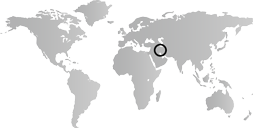The 1600s in Iran are ushered in with strengthened borders and a revived economy under the aegis of Shah ‘Abbas. The country’s role in international trade attracts many Europeans, whose art provides fresh inspiration for the Persians. This golden age comes to an end with the death of ‘Abbas. His successors, raised in the harem and not sent out to govern the provinces, do not develop the necessary administrative skills to maintain the empire, and the Safavid polity is once again weakened. In the 1700s, a number of Turkmen tribes rebel against the shahs, and Afghan groups on Iran’s borders launch a series of invasions, culminating in the 1722 occupation of Isfahan. The dynasty is thus effectively put to an end, although further descendants of the Safavid line are placed on the throne as puppets by the Zand and Afsharid dynasties. These dynasties are short-lived, however, and it is not until the Qajars prevail at the turn of the nineteenth century that a long-lasting peace is restored in Iran.


